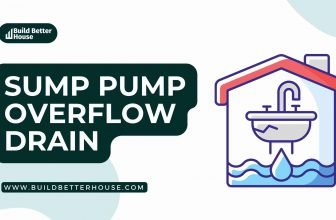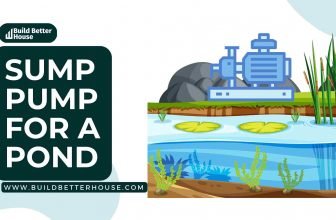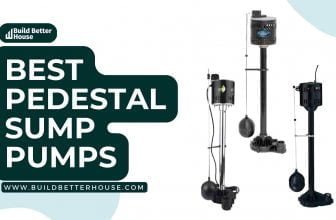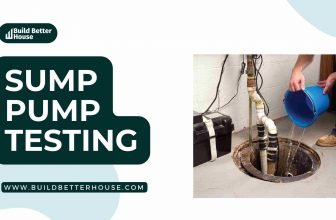How To Clean My Sump Pump? Check Out Best Sump Pump Cleaners
Sump pumps are essential to maintaining a dry basement. They need regular cleaning to keep their systems functioning as they are necessary household appliances. Cleaning a sump pump with quality sump pump cleaners is imperative to keep it odor-free and free of germs.
It includes cleaning the sump pump, check valves, drain valves, and pit. We recommend cleaning your sump pump at least once every six months and checking it after a heavy storm or snowfall. Dirt or dust and other debris that float in with groundwater will build up and ruin your pump, costing thousands of dollars in water damage if it is not clean.
If you reside in a location with frequent flooding or many groundwater sources, it is preferable to clean and drain your entire pump system once a month, mainly if you are using it to drain your washing machine.
Many people know that they should clean their system with better sump pump cleaners from time to time but are still determining how to move ahead. So, if you didn’t clean your sump pump a while ago, or if this is the first time you are even considering it, keep reading for the 8 steps to clean your pump properly.
Best Sump Pump Cleaners
Cleaning your pump is not easy, so we have compiled a list of a few sump pump cleaners to assist you in completing the process and killing any growing mold. These cleaning solutions will help remove dirt, grime, and mold with a sponge or cloth.
- Cleaning With Vinegar
Among sump pump cleaners, vinegar is one of the most effective disinfectants.
Cleaning your system with vinegar is a quick and simple way to maintain the system and avoid clogs. Since virtually everyone already has vinegar in their home, it is also one of the most excellent emergency cleaners.
Filling a spray bottle with vinegar and carrying a sponge with your scraper is the simplest method to utilize vinegar. The best vinegar to use is household vinegar; however, you can also use cooking vinegar if you don’t have any other bottles on standby.
Vinegar is a highly acidic substance. Its enzymes break down even the most persistent grime, dirt, and grease. It’s not only an excellent cleaning solution for floors, tiles, and bathtubs, but it’s also an excellent sump pump cleaner.
- Cleaning With Bleach
One of the most prevalent ways to clean and disinfect your system is to wipe it down with hot water and bleach.
Bleach can use to eliminate bacteria and germs lurking in the damp, dark pit. Start cleaning after mixing a few capfuls of bleach with hot water! For bleach to work, you don’t need much of it.
In contrast to other sump pump cleaners, bleach is an oxidizing agent. To eliminate germs and whiten pigments, oxidizing agents interact with surfaces and disrupt chemical bonds. However, they don’t truly take away the dirt on their own. So you’ll need to clean and rinse the area and then apply a bleach solution to disinfect.
BUY NOW
Clorox Splash is a laundry bleach with a thicker formula, which provides a more controlled pour and fewer spills. This liquid leach quickly removes all hard stains from the surface. With its scented formula, it removes all stains and deodorizes surfaces.
This helps to eliminate odors from your sump pump and keeps it fresh for longer. This product should handle with rubber gloves to prevent eye and skin irritations.
Step-by-Step Sump Pump Cleaning Guide
Are you having trouble preventing sump pump dirt and odor? Check out our 8-step guide!
Materials Needed
- A bucket of hot water
- Garbage bag
- Shop Vac
- Soap, Vinegar, or Bleach
- Scraper or Flat head screwdriver
- Spray bottle or sponge
- Plastic gloves
- Flashlight
Disconnect The Power, Battery, and Alarm
The first step is disconnecting your pump from the power source and other accessories, such as the backup battery and alarm. It is preferable to do so since the entire unit must wipe down with bleach or vinegar during the cleaning process.
Moreover, standing water may cause damage to your system and internal electronics during the cleaning process.
Disconnect from Discharge Pipe
The next step is to disconnect the discharge pipe from your pump. You should be able to slide the pump and pipe apart by loosening any screws or fasteners connecting them.
If you encounter resistance, it could be due to moldy buildup in the pipe and pump end. To kill growth and prevent it from returning, clean this area with bleach or disinfecting vinegar.
If you cannot separate the pump from the pipe, you can use any lubricants (WD-40) to loosen things up before damaging your costly pump!
Remove from the Pit
New homeowners make a mistake by simply trying to clean the sump pump while it is still inside the pit. Cleaning the pump inside the sump pump pit merely moves the mess around.
If you want to thoroughly clean your pump and basin, place them in a trash bag and take them out into the backyard. You will have much more room to clean in the backyard and not worry about spilling grime on your basement carpet.
Scrape Sludge and Rust
When you get outside, it’s time to get cleaning your pump. To begin, scrape mold, mildew, or material buildups with a sponge, warm cloth, or even a flathead screwdriver. Use a garden hose to knock it away if it’s too much to remove by hand.
Check for rust or metal corrosion near the power supply and pump body. If you leave a metal rest in your pump, the system’s lifespan will significantly reduce!
Disinfect Basin
It is just as important to disinfect your sump pump basin as disinfect your pump. Remember to wipe down your cover, especially the underneath cracks. Debris and other particles can accumulate in the bottom and sides of your sump pump over time.
Disinfect the Pump
After cleaning up all the mold and grime, disinfect the pump and pump basin. Wipe the pump’s exterior with any of the above-mentioned sump pump cleaners; bleach, vinegar, or another disinfectant.
Since mold, mildew, and other germs can live in cracks and crevices, ensure the entire unit disinfect. Make sure to clean the check valve and float switch as well.
Clean with Shop Vacuum
Remove the remaining water and debris from the pit’s bottom with your vacuum. It’s nearly impossible to clean all the leftover water and pump particles by hand. Using a vacuum, you can clean your system quickly and restore your pump pit to its original condition.
When you finish, always remember to empty the vacuum. You don’t want to leave it quickly since it will be full of dirty water, mold, mildew, and oily particles.
Reattach and Test
Reattaching the pump is the final step in the cleaning process. Begin by reconnecting the discharge pipe, adding necessary supports, and connecting the alarm and backup battery to the power source. Fill your sump pump basin with a few buckets of water and test the pump once everything is in place!
Cleaning The Drain Pipe
Keeping the drain pipe clean is just as important as cleaning the pump and basin. Pour a few buckets of water down the discharge pipe every once in a while. It would also be better to disinfect the pipe’s exterior and interior, including the check valve.
Sump Pump Cleaners: Top Cleaning System On The Market
Are you worried about cleaning your sump pump? Need more time and patience to invest in your system? Let us help you!
If you do not want to avoid dealing with the hassle of cleaning your sump pump frequently, the best option is to buy budget-friendly sump pump cleaners.
Sump pump cleaners are an excellent addition to your systems. Unlike traditional methods of removing dirt from your sumps, Sump pump cleaners significantly reduce the labor required to clean your sumps effectively. Your coolant management greatly simplifies with properly sized Sump pump cleaners.
There are numerous sump pump cleaners on the market; however, let’s look at our top picks for sump pump cleaners.
Eriez HydroFlow Sump Pump Cleaners
Eriez HydroFlow Sump Pump Cleaners are an efficient filter coolant for removing sludge and chips from sump pump machines and tanks.
Sump pump cleaners from Eriez can effectively, thoroughly, and quickly clean machines to decrease machine tool downtime and maintain plant productivity. With the industry’s most comprehensive line of sump pump cleaners, Eriez HydroFlow has a solution for almost any application need.
Eriez’s sump pump cleaners range from low-cost drum top cleaners and reversible liquid vacuums to high-quality sump cleaners.
Eriez’s sump pump cleaners are vacuum unit that converts an existing open-top drum into a powerful machine tool sump cleaner that quickly and efficiently picks up tramp oils, used oil, and waste coolants. The unit can also remove chips and fines, making it more affordable than dedicated sump pump cleaners.
Prab Mobile Sump Pump Cleaners
The Prab Mobile Sump Pump Cleaners (HSC) successfully increase the life of costly metal-working fluids and coolants.
Grinding swarf, dry sludge, metal chips, and other particles are easily removed and filtered by the HSC. It is intended for a simple, low-maintenance operation to remove solid impurities from machine tool sumps and other tanks and pits.
Since all units are made of carbon steel and other high-grade materials, the HSC is ideal for demanding industrial applications. The HSC simplifies industrial fluid and handles it at a low cost to all organizations.
These sump pump cleaners have a 100-gallon-per-minute pumping capacity and a holding capacity of up to 600 gallons. This system makes it simple and economical to keep your machine’s fluid maintenance routine on track.
The HSC is a standard vacuum system with a pre-filter built specifically for solids removal. It is simple to use, portable, and can fit into even the smallest business floor design.
Suction hoses are used to remove contaminated material from the machine sump. The fluid is pulled through the internal filter basket of the cleaner and kept within it. Also, every unit has an overfill protection system to stop operation and safeguard the vacuum.
Nilfisk Attix 19AE Sump Pump Cleaners
The Nilfisk Attix 19AE Flood Sucker, often known as the “ultimate sump pump vacuum,” collects and discharges nearly 1 gallon of water every second. This high-performance shop vac is ideal for flood repair, abatement contractors, and fire agencies.
The Attix 19AE Flood Sucker separates particles and liquids and is composed of solid stainless steel. It has three modes of operation and a power regulator. It also comes with a heavy-duty trolley for effortless mobility into various locations.
Unlike conventional flood vacuums, which leave about an inch of water after cleaning, the Nilfisk Attix 19AE leaves a dry surface behind.
The reversible liquid vacuum is another excellent choice for clients who need to clean their sump or remove liquid. It is designed to connect to a closed-head drum and remove lubricating or hydraulic oils from the basin.
Conclusion
It is essential to clean your sump pump system at least once every six months to keep it running smoothly. The more you clean your sump pump, the less likely it is to accumulate dirt and grime over time. If you don’t clean your pump often enough, you may notice a decrease in performance or damage to the pump’s components.
Using high-quality sump pump cleaners is the most effective way to clean your sump pump. These cleaners are designed to remove mud, dirt, and debris from your sump pump. Use these products once every six months to maintain your sump pump and keep it running smoothly.
When using sump pump cleaners, always follow the manufacturer’s instructions and wear protective gear, such as rubber gloves, a mask, and a pair of glasses.
How often should I clean my sump pump?
Clean your sump pump at least once every 6 months to keep it running smoothly and avoid odors.
Is it necessary to clean the sump pump?
Yes. A dirty pump will be less effective and may begin to stink up the basement.
Will bleach damage the sump pump?
No. Bleach is safe for sump pumps and is recommended for cleaning and disinfecting the system.
Can I pour vinegar into my sump pump?
Yes. Vinegar, similar to water and removes buildups, is an excellent choice for cleaning the inside of your sump.
FAQ
How often should I clean my sump pump?
Clean your sump pump at least once every 6 months to keep it running smoothly and avoid odors.
Is it necessary to clean the sump pump?
Yes. A dirty pump will be less effective and may begin to stink up the basement.
Will bleach damage the sump pump?
No. Bleach is safe for sump pumps and is recommended for cleaning and disinfecting the system.
Can I pour vinegar into my sump pump?
Yes. Vinegar, similar to water and removes buildups, is an excellent choice for cleaning the inside of your sump.
Related Articles
5 Best Sump Pumps On The Market: Our Top Picks
Top 5 Under-Sink Sump Pumps Available In The Market
Sump Pump Running No Rain – How To Fix It?






